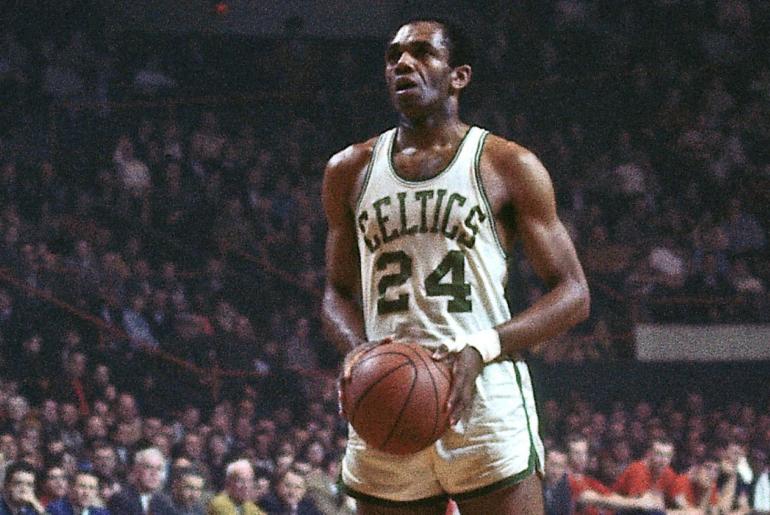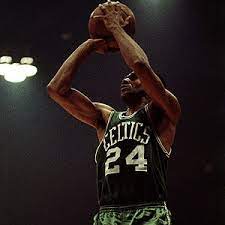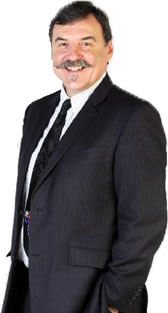Bob's (& Pat's) Corner: Sadly, Sam won't play it again
TweetBOB'S (& PAT'S) CORNER: OUR USA correspondent and former import BOB CRAVEN is joined this week by another former import in PAT WHALEN as they revisit the passing of Boston Celtics legend Sam Jones, Pat with a story from BOB RYAN. Enjoy.
.jpg) NBA Hall of Famer, Sam Jones, of those magnificent Boston Celtics teams of the ‘50s and ‘60s passed away a few days ago at age 88.
NBA Hall of Famer, Sam Jones, of those magnificent Boston Celtics teams of the ‘50s and ‘60s passed away a few days ago at age 88.
He, KC Jones and Bill Russell all came to the Celtics almost simultaneously back in the day. Russell jumped right in as the starting centre, while KC and Sam initially were the backups to their existing backcourt starters, Bob Cousy and Bill Sharman.
As those two were veterans, it didn’t take very long before they retired, and then Sam and KC became the starters for many years.
Sam was famous for being one of the first major proponents of using the backboard for his mid-range and longer jump shots, especially from the left side. I became a fan of his and have always had a soft spot for his excellent career.
As a youngster in junior high/middle school, I thought his bank shots were cool and I started to work a lot imitating him on using the backboard on shots that were not inside the key.
As I got into high school and university, I continued to do that, although I did not use it in games a lot. However, playing H-O-R-S-E with friends and teammates was another matter.
I also started using the backboard on shots from straight out in front of the rim, which almost no one else would do. I became the bank shot H-O-R-S-E champion doing that, to the point that most who knew me wouldn’t take me on, or even play me in bank shot free throws.
Jones won 10 NBA championships with the Celtics.
HERE'S the additional feature on Sam Jones by BOB RYAN, supplied to B.O.T.I. by blog supporter and another past Aussie basketball import, PATRICK WHALEN...
SO much about the Sam Jones story must read like some sort of basketball science fiction to any modern hoop sensation.
Sam was a 24-year old rookie in 1957 because his junior and senior years at North Carolina Central were interrupted by Uncle Sam, who demanded, and received, two years of the young man’s time.
Sam was drafted as the 8th pick of the first round by Red Auerbach, as the story goes, sight unseen. Wake Forest coach Bone McKinney, who had played for Red back in his early days with the Washington Capitols, had recommended him to his old boss. Red never refuted the story.
Sam patiently waited until his fourth season before becoming a starter. He was playing behind Hall of Famer Bill Sharman and he never opened his mouth.
And now let me assure just about every puffed-up shooting guard in today’s NBA that no matter who you are, there is very little chance you are as good as Sam Jones, who passed away at the age of 88.
I have long been of the belief that Sam Jones, who was inducted into the Naismith Memorial Basketball Hall of Fame in 1984, was its most underrated member. Yes, people kinda sorta assumed he was good because he was associated with all those great Celtics teams of the 50s and 60s, but they more than likely didn’t know HOW good.
Imagine, for example, you are an NBA general manager or player personnel director and a trusted scout of yours files the following report on a 6-4 guard he has been following.
“Rangy, and amazingly quick. I have never seen a more explosive first step on anyone going to the basket. A terrific mid-range shooter. And he is the absolute master of the bank shot. Don’t foul him. He’s an 80-percenter from the line. I followed him for a half-dozen games and he was always the man they wanted to the the big shot. And, oh, yes, he can, and will guard you.”
That was Sam Jones.
He was the steal of the 1957 draft. The first pick went to Los Angeles, and they took West Virginia star Hot Rod Hundkey. Fine. He was never as good in the NBA as he was in college, but he was a solid pro.
Are you ready for the next six picks? Here goes…Charley Tyra, Jim Krebs, Win Wilfong, Brendan McCann, Lenny Rosenbluth and George Bon Salle. As an ensemble, these six chaps played in 1254 games, none of them belonging to Bon Salle. Sam played in 871 regular season and 154 playoff games while earning 10 championship rings and becoming a member of the NBA’s 25th, 50th and 75th Anniversary teams.
And it almost didn't happen.
Sam Jones was not at all certain he wanted to play professional basketball He had graduated with a degree from North Carolina Central and was fully prepared to become a teacher, which, he figured, would provide him with three squares a day and enough income to give his fiancé Gladys a reasonably secure life. He was vaguely aware of the newly-crowned NBA champion Celtics, but that’s about it. “I didn’t know anything about Bob Cousy or Bill Russell,” he told interviewer (and book collaborator) Mark Bodanza in a 2019 interview. Now it gets REALLY good. He was also hesitant about coming to Boston because: “With them being a championship team why would they ever cut anybody?”
But guess who told him that if he didn’t try to play in the NBA he might wind upon regretting it for the rest of his life? That would be Gladys, his wife of 60 years before her passing in 2018. “Greatest decision I ever made,” he said, “and it was all because of her.”
It was a completely different basketball world. Sam and (no relation) K.C. Jones served as game-changing subs while waiting for Sharman and Cousy, the pre-eminent NBA backcourt of the 50s, to retire. Sharman left after the 1960-061 season and Sam would begin a seven-year run averaging between 18.4 and a then Celtics’ single-season high of 25.9 in ’64-65. Among the highlights was a 47-point explosion in Game 7 of a very competitive 1962 playoff series with the Cincinnati Royals of Oscar Robertson and Jerry Lucas and a 51-point outburst in a Game 4 sweep of the Knicks in 1967.
He also distinguished himself in 1962 when he picked up a photographer’s stool on a Sunday afternoon at the old Garden to protect himself from a rampaging Wilt Chamberlain, a move that made an impression on the first round draft choice making his first visit to Boston. Yup, John Havlicek.
On a more serious note, it was Sam Jones who led a revolt of Celtics black players by refusing to play an exhibition game after he and Satch Sanders had been denied restaurant service in a hotel which had grudgingly allowed them to sleep in. He found out what Red Auerbach was all about when the coach drove his black players to the airport.
Sam Jones and Russell were very tight. “We talk six or seven times a month,” he said. Sam was enormously proud of the fact that they were the most decorated teammates in the history of American team sport with a combined 21 championship rings. He bled green, for sure. “I remember that Lou Gehrig said that the greatest part of his life was being a Yankee,” Sam explained in that Bonanza interview. ‘I felt the same way about being a Celtic.”
Damn, was he good, and never more so than when they threw the money on the table. Check out his averages from ’62-63 to ’67-68: 23.8, 23.2, 28.6, 24.8, 26.7 and 20.5. He went out on a high note in 1969. He averaged 16.8 as a 36-year old shooting guard in the playoffs, the keynote moment being the famed bounce-around winner in Game 4 of the Finals against the Lakers.
Getting 21 in Game 7 was a fitting farewell. “It felt good,” he said. “That year we weren’t supposed to win. But in our hearts we knew we had an opportunity to win another championship if we were healthy — key word.”
We have to end with the bank shot. How many people are almost exclusively associated with one patented maneuver? Kareem with the hook, Dirk with the step-back, Curry with the ultra-bomb. Yup, yup and yup. And then there was Sam Jones, who owned the banker.
It was a life well-led, on and off the court. We now live in a diminished world.
TOMORROW: Bob's back going solo with a retrospective BOB'S CORNER.


